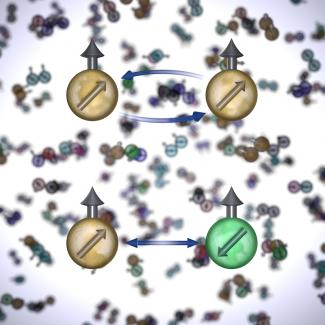Symmetries described by SU(N) group theory made it possible for physicists in the 1950s to explain how quarks combine to make protons and neutrons and JILA theorists in 2013 to model the behavior of atoms inside a laser. Now, the Ye group has observed a manifestation of SU(N≤10) symmetry in the magnetic behavior of strontium-87 (87Sr) atoms trapped in crystals of light created by intersecting laser beams inside a quantum simulator (originally developed as an optical atomic clock).
This first-ever spectroscopic observation of SU(N) orbital magnetism in 87Sr atoms cooled to micro-Kelvin temperatures was reported online in Science Express on August 21, 2014.
Several advances made this observation possible: (1) Seminal theory work by the Rey group predicting the magnetic behavior of 87Sr atoms at cold and ultracold temperatures; (2) Exquisite measurement precision available from an ultrastable laser developed for the 87Sr-lattice optical atomic clock; (3) The ability to freeze out the motional states of the atoms, but preserve the flow of information, at relatively “high” μK temperatures; (4) The use of 87Sr atoms, whose 10 nuclear spin states are decoupled from their interparticle interactions; and (5) The experimental control of the number of 87Sr atoms in the ground and excited electronic states used as orbitals.
This groundbreaking work opens the door to (1) precision studies of collisions between nearly identical 87Sr atoms that differ only in the states of their nuclear spins, (2) a deeper understanding of the role of atomic orbitals in collisions and chemical reactions, and (3) investigations of quantum magnetism and exotic materials. For instance, theorists have predicted that a chiral spin liquid will form if 87Sr atoms are prepared in all 10 nuclear spin states and cooled down in a two-dimensional lattice (crystal of light). This exotic substance has no apparent order even at ultralow temperatures approaching absolute zero!
The researchers responsible for launching this new, exciting work include research associate Xibo Zhang, graduate students Mike Bishof and Sarah Bromley, research associate Christina Krauss and Professor Peter Zoller of the University of Innsbruck (Austria), Professor Marianna Safronova of the University of Delaware as well as Fellows Ana Maria Rey and Jun Ye.—Julie Phillips.



 The Physics Frontiers Centers (PFC) program supports university-based centers and institutes where the collective efforts of a larger group of individuals can enable transformational advances in the most promising research areas. The program is designed to foster major breakthroughs at the intellectual frontiers of physics by providing needed resources such as combinations of talents, skills, disciplines, and/or specialized infrastructure, not usually available to individual investigators or small groups, in an environment in which the collective efforts of the larger group can be shown to be seminal to promoting significant progress in the science and the education of students. PFCs also include creative, substantive activities aimed at enhancing education, broadening participation of traditionally underrepresented groups, and outreach to the scientific community and general public.
The Physics Frontiers Centers (PFC) program supports university-based centers and institutes where the collective efforts of a larger group of individuals can enable transformational advances in the most promising research areas. The program is designed to foster major breakthroughs at the intellectual frontiers of physics by providing needed resources such as combinations of talents, skills, disciplines, and/or specialized infrastructure, not usually available to individual investigators or small groups, in an environment in which the collective efforts of the larger group can be shown to be seminal to promoting significant progress in the science and the education of students. PFCs also include creative, substantive activities aimed at enhancing education, broadening participation of traditionally underrepresented groups, and outreach to the scientific community and general public.